PIRARUCU FACTS
Biological Features

Arapaima gigas Schinz, 1822 [Osteoglossidae]
FAO Names: En - Arapaima, Fr - Pirarucu, Es - Paiche
Elongated fish with relatively small pectoral fins on the sides close to the head. The coloration is grey-green with golden iridescence frontally extending back with orange specks along the rest of the body; some fins sometimes edged in red; belly white. Tongue bony. Large scales cover entire body except the head, which is ornamented on the surface. Dorsal and anal fins at the same level close to the tail fin, which is rounded and exhibits an intense red colour.
Arapaima can attain lengths of >3 m and weights of >200 kg. Some reports indicate a maximum length of 4.5 m.
Arapaima gigas is an air-breathing giant fish of the Amazonian rivers; this characteristic gives this species an advantage in oxygen-deprived waters.
Historical Background
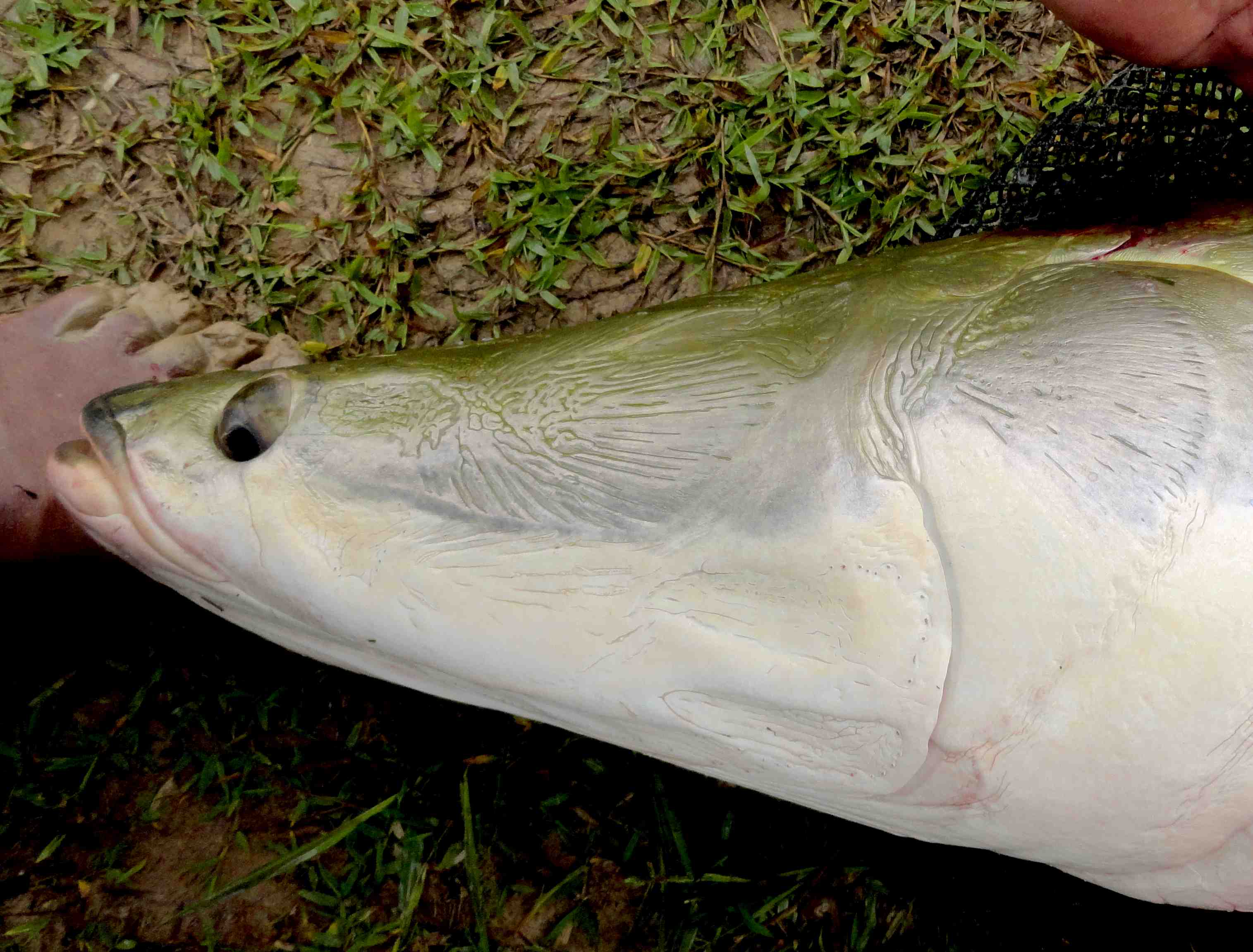
Arapaima adult head
The natural distribution of Arapaima gigas was the Amazon basin, except the Bolivian and south Peruvian (Madre de Dios basin) areas. However, about 30 years ago, arapaima (also known as Piracucu) was intentionally or accidentally introduced from the Ucayali basin to the Madre de Dios basin in Peru and it has now spread all over the north Bolivian amazon basin. It has also been transferred to the northeast and south of Brazil and to some coastal areas of Peru. It has also been reported that arapaima has also been introduced into Bolivia, China, Cuba, Mexico, Philippines, Singapore and Thailand.
Currently, in 2012, the farming of arapaima provides a new opportunity but the current production level is still very limited and production statistics are very difficult to verify. Nevertheless it is estimated that the total production in the amazon area (mainly in Brazil and Peru) is a few hundred tonnes. A few attempts to rear this species have been observed in Colombia and Ecuador.
Habitat and Biology
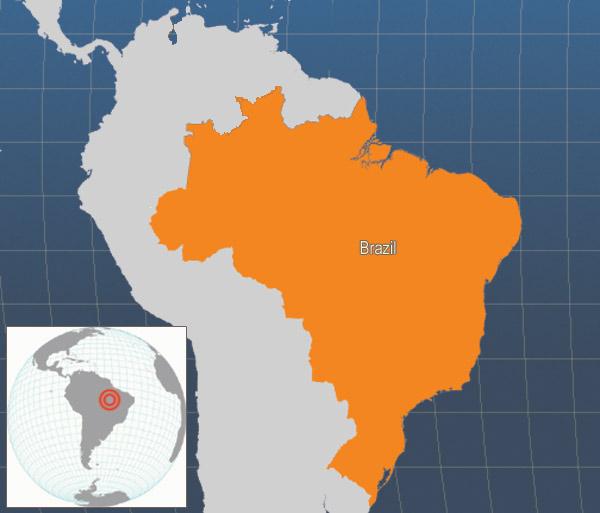
Main producer countries of Arapaima gigas (FAO Fishery Statistics, 2010)
Arapaima gigas is the largest scaled fish species living in the Amazon basin. It is an emblematic species of the Amazonian fish fauna and is known as paiche in Peru and arapaima in Brazil. It has very attractive potential for aquaculture in the Amazon region, owing to its many advantages. These include:
- It has the best growth rate among the Amazonian cultivated fish species - 10-15 kg/yr.
- Its filet, which is very popular, does not have intramuscular bones.
- It tolerates low water dissolved oxygen levels, due to its obligatory aerial breathing.
- Although it is carnivorous it will also consume dead fish and fish feed pellets.
In the wild reproduction occurs mainly during the rainy season but continuous reproduction has been observed in captivity. Eggs are relatively large, ~2.5-3 mm in diameter, but batch fecundity is relatively low - 10 000 to 20 000 mature oocytes for an 80 kg female. Eggs are laid in circular nests of approximately 50 cm wide and 15 cm deep. Arapaima is not a mouth brooder, unlike Osteoglossum bicirrhosum (arawana), but both parents take care of the offspring for at least one month until the group disperses throughout the lake or pond. The female arapaima helps to protect the male and the young by circling them and fending off potential predators.
Given its great economic and cultural importance, the aquaculture development of this species represents an evident solution to solve the decline in wild populations due to over-fishing.
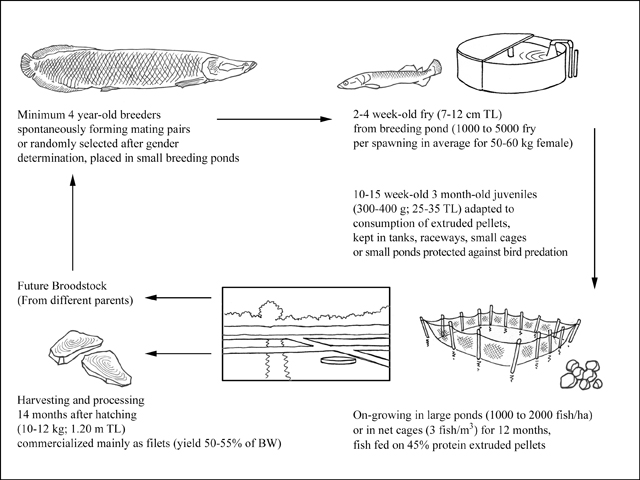
Production Systems
Seed Supply
Commercial aquaculture of this species is a recent activity in Peru and Brazil. As this species is in the CITES II section (strictly regulated and controlled commerce), its aquaculture development must now rely solely on spontaneous reproduction in captivity. Reproduction generally occurs in large earthen ponds where stocks of a few tens of brooders are maintained together at the beginning of the rainy season (December–March in the Peruvian Amazon). Male and female pairs build a nest, delineate a territory and guard the offspring for at least 20 days from other arapaima and/or predators. Spawning in captivity is continuous and some mating pairs can reproduce five to seven times a year, especially when they are isolated in smaller ponds.
Broodstock
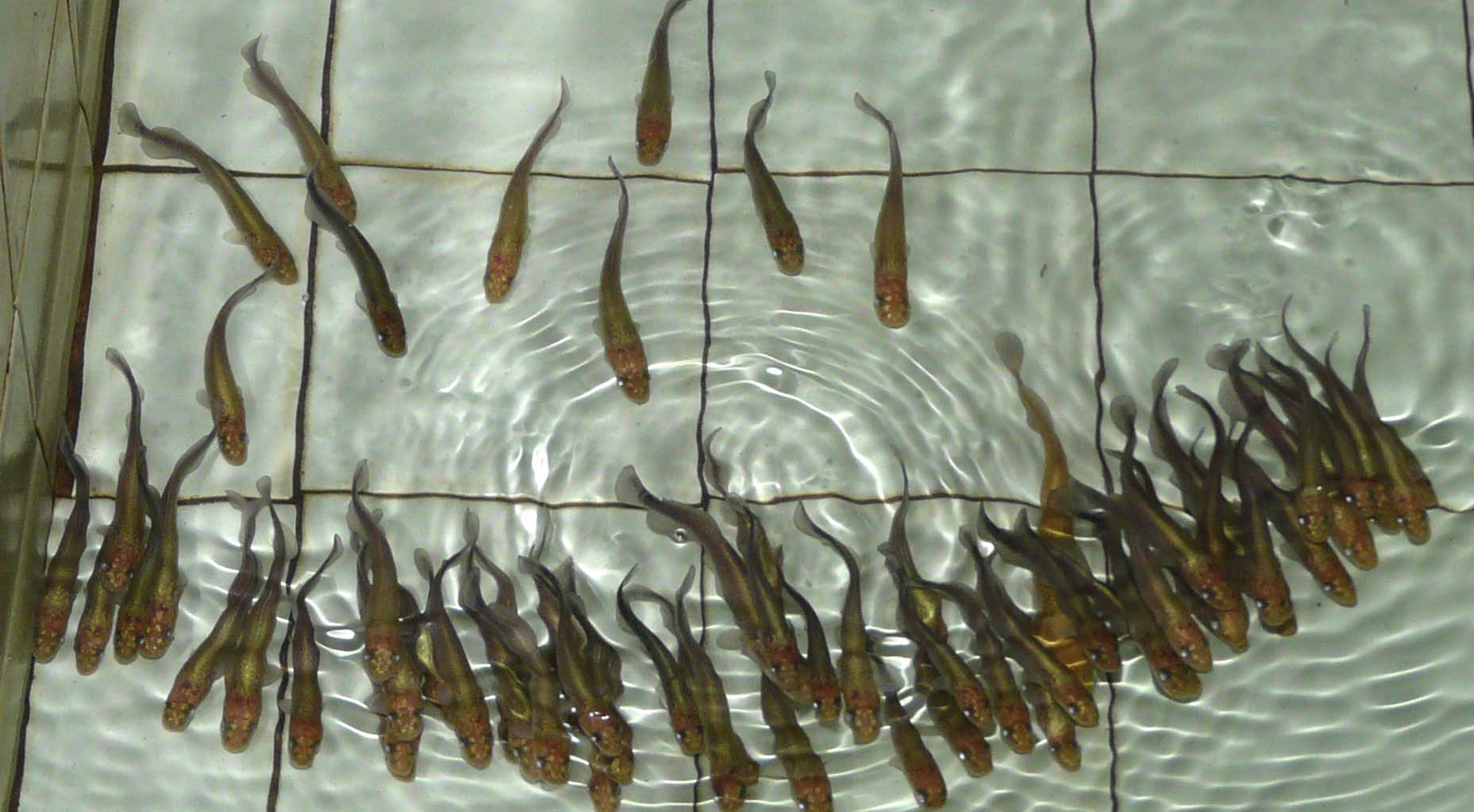
Juveniles
Generally the first broodstocks were established relatively recently with fish captured outside the reserved areas, or from reserves that have management plans implemented with the collaboration of the autochthonous populations. These have really contributed to the protection of this species in Mamirauá (Brazil) and Pacaya-Samíria (Peru) natural reserves.
Fry production is presently the principal bottleneck for the development of arapaima aquaculture production. The peculiarities of its reproductive behaviour (territorial mating pairs) and the relatively low fecundity of females make massive fry production difficult and costly.
Adequate broodstock management would normally include the sexing of the brooders but this is difficult with arapaima. No external characteristics are observed during most of the year. Sometimes male jaws are more red-coloured during the reproductive period but this characteristic is not always clear enough to be usable as a routine sexing technique. However, an Enzyme Immuno Assay (EIA) technique has been developed using antibodies to Arapaima vitelllogenin. This antibody has been recently used to develop a ‘sexing-kit’ that can be used directly in the field.
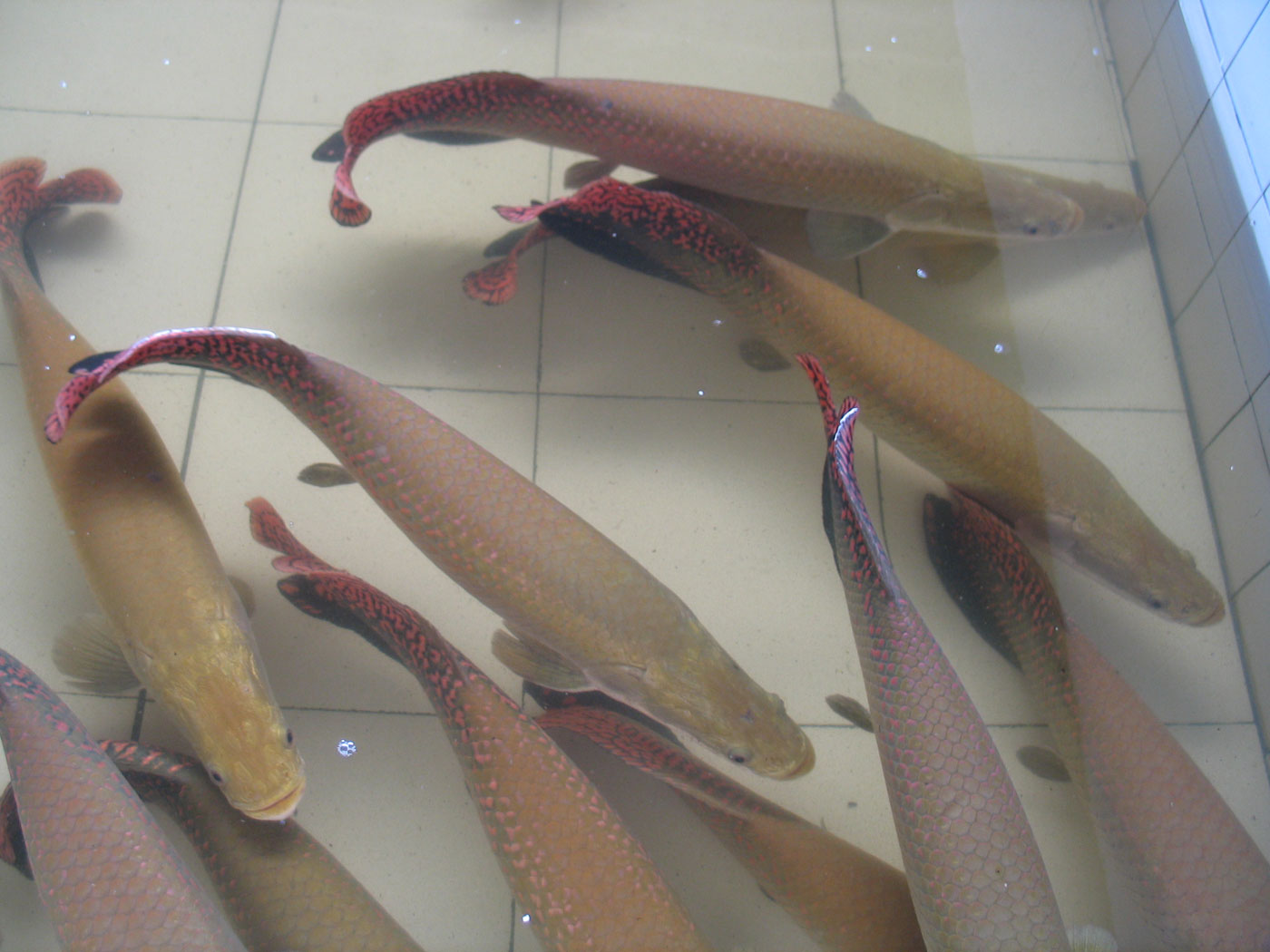
Arapaima gigas
Breeders are usually fed with fresh, frozen or extruded food specially formulated for arapaima, with a high fish protein level (40 percent). Once the mating pair is formed the two breeders are placed in small ponds to allow courtship behaviour and spawning. The fry produced per spawning can vary from a few hundreds to a few thousands, depending on female size and on fry survival. As fry feeding only relies on the natural food present in the pond, the management of plankton production during the reproductive period is a prerequisite to obtain better fry survival. It is also necessary to control fry predators such as birds or other fish species.
The fry produced under these conditions are generally harvested at 7-12 cm (2 to 3 weeks after hatching) and are adapted to extruded food during a period of ~1 month in small tanks using a progressive dry feed substitution through the feeding of small fish and fish meat that has been previously chopped and mixed with ground extruded pellets.
A survey in Peru in 2011 as shown that the average fry production per female and per year ranged from 26 to 1063 depending on broodstock and pond management conditions.
Hatchery production
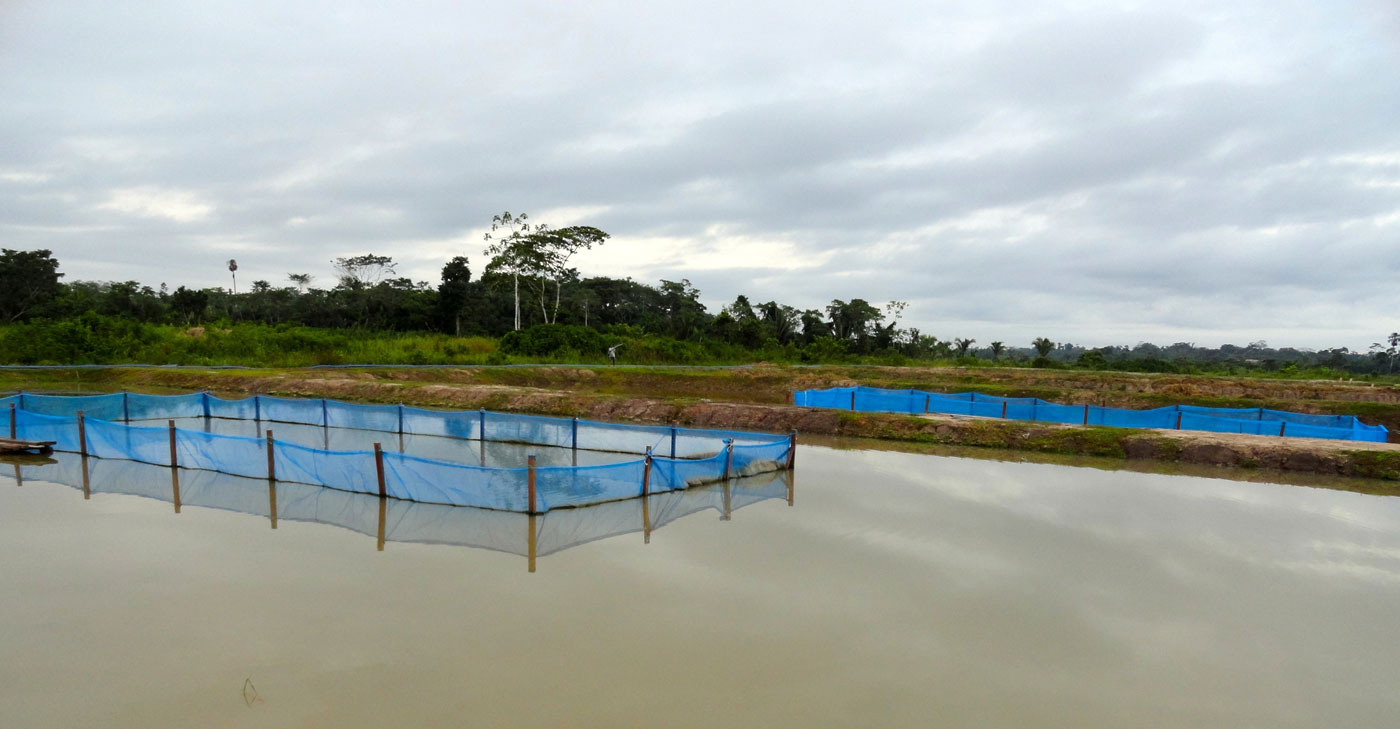
Fry production cages
Trials have been performed using freshly spawned eggs obtained from pond bottom nests and incubating them in special baskets (as the eggs are sticky they have to be continuously in movement to get well aerated. The system consists of a 50 cm diameter basket with a plastic net at its bottom (mesh size 1 mm) where the eggs are placed and which is attached to a system that makes the basket go up and down) in well-aerated water. These reports of hatching success are encouraging and this may also increase the overall fry yield per spawning. This system requires careful management skills and generates higher costs but may make the quantity of fry available after each spawning more predictable.
Recently some cases of fry collection as soon as they first appear at the pond surface and their transfer to tanks or raceways have been reported. However, even if this method appears to give improved survival rates, it is necessary to provide Artemia nauplii (combined with natural zooplankton if available) and to progressively supply artificial food.
Nursery
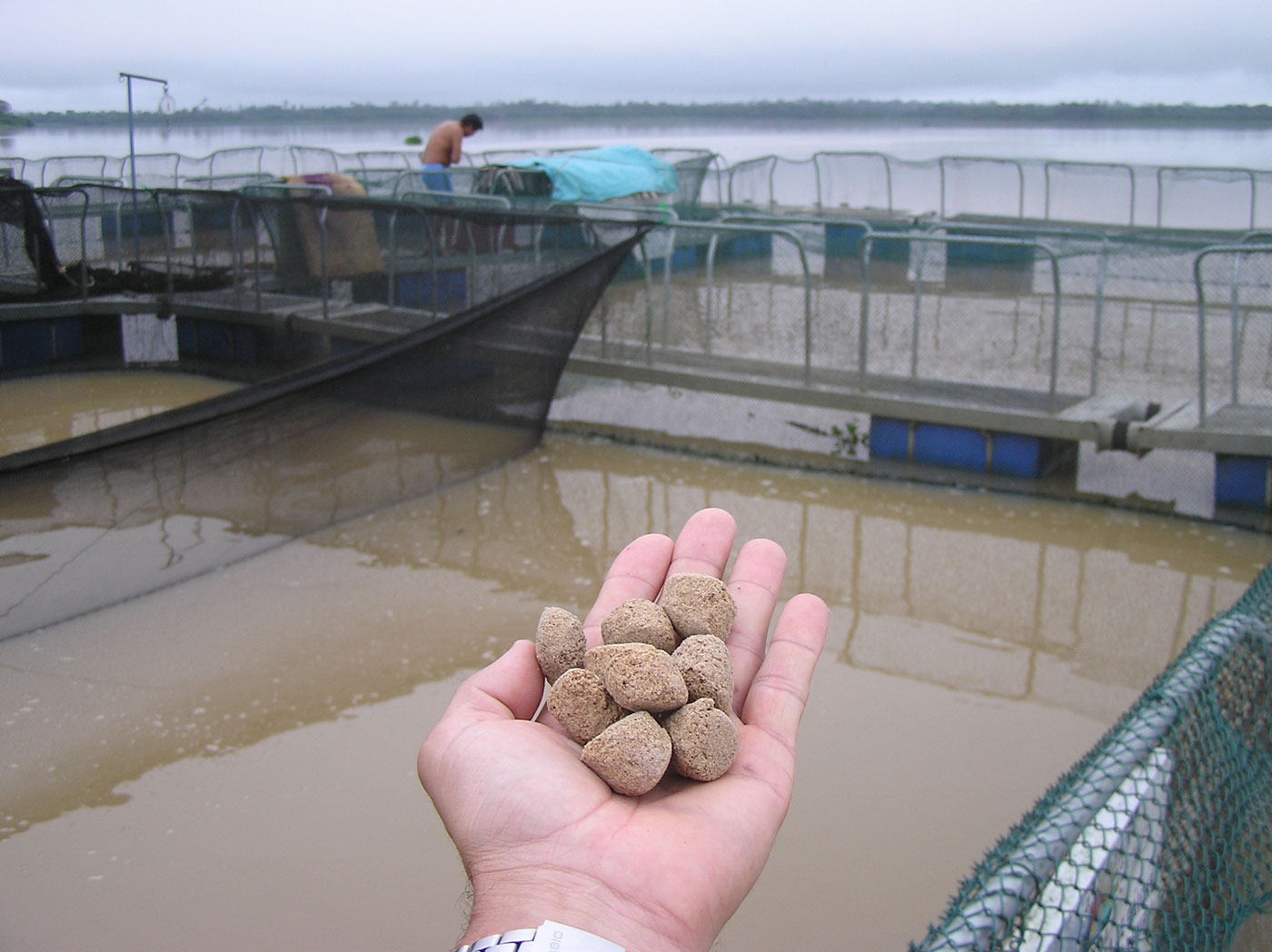
Ongrowing cages and pellets
The following information is based on available rearing information from Perú and Brasil:
Two to three week-old fry collected from reproduction ponds (7-12 cm, 5-10 g) are acclimated to accept dry extruded feed containing 55 percent protein (mainly fish protein); this is generally performed in small rectangular tanks (2x1x0.5 m) stocked at 50-100 fish/m2 or in circular tanks (1.5 m3) stocked at 200-250 juveniles/m3. Feed is distributed 4 times a day at 15 percent of BW (Body Weight) ad libitum, using chopped fish fillet mixed with ground dry feed which allows the formation of moist pellets that are ingested immediately by the fish as soon as they touch the water surface. If the pellets sink, they are not consumed and remain at the bottom of the tank. These moist feed pellets are progressively replaced by 2-3 mm dry feed pellets over a four-six week period. The successful level of adaptation generally reaches values of >70-80 percent and the mortality is generally <10-15 percent. During this phase fish are very sensitive to bacterial and parasitic infections, so maximum care is necessary to avoid massive mortalities. After this period the 40-60 day-old juveniles weigh 40-60 g and reach 18-25 cm TL.
These young juveniles are then transferred to small net-cages (10x5x1 m) or ponds (100-1 000 m2) at densities of 5-10 fish/m2, fed three times daily with 5-8 mm extruded pellets containing 55 percent protein at a rate of 10 percent of BW. After 30 days the 2.5-3 month old juveniles reach 300-400 g and 40-45 cm TL, with survival rates of >95 percent. At this time they are ready for ongrowing in larger ponds or net-cages.
Net-cages of 300 m3 (10x10x3 m) are stocked at 3 fish/m3 or 1 fish/5-10 m2 in 0.5 to 5 ha 1.5-2 m deep earthen ponds. Ponds are not previously fertilized and water exchange is limited to replacing evaporation and seepage losses. Arapaima depends mainly is an obligate air-breathing fish. In ponds as well as in cages. Arapaimas are fed three times a day starting at 5-7 percent BW with extruded floating pellets (containing 45-50 percent protein) of graded sizes that rise to 30 mm at the end of the ongrowing phase. Then the ration is progressively reduced to 1 percent by the 9th ongrowing month, by which time (12 months post-hatching) most of the fish have reached the marketable size (10-15 kg; 110-120 cm TL) with survival rates >95-98 percent.
Feed Supply
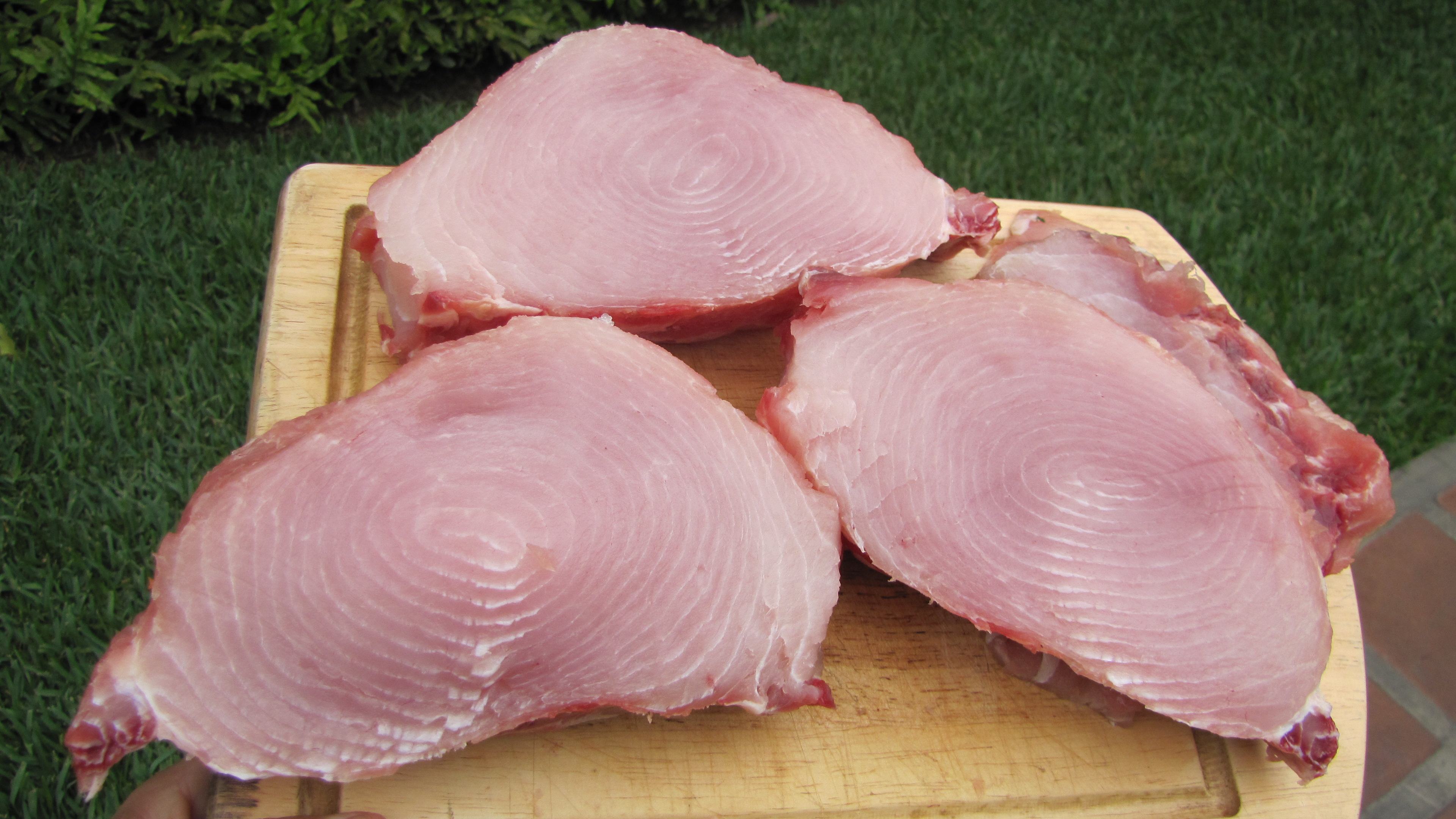
Arapaima fillets
Fish are fed with high protein (50-55 percent) extruded pellets for the first 3-4 months and then with 40-45 percent protein feeds for the following months. FCR (Food Conversion Ratio) of 1.7-2.3 have been reported, using feeds from various manufacturers. The cost of a commercial feed that is specially formulated for arapaima in Peru is USD 1.5-2.0/kg and has an apparent FCR ~1.8 to 2.0.
Harvesting techniques
Arapaimas of 10 to 15 kg are generally captured with net seines from ongrowing ponds.
